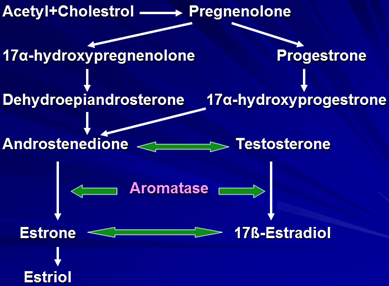Estrogens
Chemistry
Steroids having phenol ring, many groups are attached, responsible for different pharmacokinetics and pharmacodynamics of different preparations
Source
- Natural/Synthetic
- Plants (fungi)
Present in animals and humans, main source is Stallion horse urine for clinical use
Synthetic are made from plastics, pesticides and many other industrial chemicals
Biosynthesis
Androstenedione has affinity for alpha receptors, action is different in different parts of body.
Classification
A. Natural Estrogens
– Estradiol
– Estrone
– Estriol
– Equilin
B. Synthetic Estrogens
I. Steroidal
– Ethinyl Estradiol
– Mestranol
– Quinestrol
II. Non-steroidal
– Diethylstilbestrol
– Chlorotrianisene
– Methallenestril
Pharmacokinetics
Routes of administration –can be given by oral/I/V/transdermal/topical applications/vaginal creams, gels
In body bind hormone binding globulin
Hydroxylation & conjugation occurs in liver to inactive metabolites
Enterohepatic circulation –pass to intestine and hydrolyzed, reabsorbed and reach liver again where conjugation occurs
If given through transdermal patch or topically, less liver effects are seen.
Mechanism of action
In body two forms of estrogen receptors are present:
α & ß
When estrogen binds these isoforms, stabilizing proteins, heat shock proteins, dissociate from receptor, estrogen receptor complex is formed. These receptors then form homo & Hetro-dimers.
Bind estrogen receptor element present on promotor region of gene to modify transcription.
Enzymes, growth factors, cytokines are involved. Transcription not only involves binding with response element, but also co-regulators – co-activators are required.
It takes longer for non-genomic effects to appear, e.g. change in blood supply of uterus, increased calcium uptake by granulosa cells.
Physiological & Pharmacological Effects
Developmental Effects
Female maturation
Development of essential internal genital organs, growth, primary and secondary sexual characteristics, development of mammary glands
Male maturation
Endometrial Effects
Required for both growth and development of endometrial lining, smooth muscles, stroma and ductal region of uterus.
Metabolic & Cardiovascular Effects
Bones / Skin / Blood vessels- suppress osteoclastic activity, inhibiting resorption of bone, required for stimulation and formation of blood vessels. In vessels cause formation of nitric oxide, nitric oxide synthetase, responsible for vasodilatation.
Proteins / Lipids –increased protein synthesis, increased plasma proteins like binding proteins, globulins (corticosteroid binding, etc.), increased formation of fibrinogen, renin substrate.
Decreased LDL and cholesterol, increased HDL and triglycerides
Effects on Blood Coagulation
- Synthesis of clotting factors,
- increased hypercoagubility,
- decreased antithrombin III,
- increased plasminogen,
- decreased platelet adhesiveness
Effects on CNS
- Feeling of well being
- Stimulate sympathetic components esp. corticotropic release
Miscellaneous effects
Promote synthesis of progesterone receptors
Facilitate movement of intravascular fluid into extravascular space leading to edema. Decrease intravascular volume responsible for stimulation of aldosterone secretion and retention of sodium and water.
Therapeutic Uses
1. Replacement Therapy
a. Primary Hypogonadism – Turner’s syndrome
Estrogen is given to facilitate pubertal changes.
b. Castration / Oophorectomy
c. Postmenopausal Hormone Therapy
Given for different reasons:
i. Vasomotor symptoms
Hot flushes alternating with chills, very troublesome. As estrogen increases the chances of cancer, in high risk individuals, Clonidine can be given.
ii. Osteoporosis
Besides measures include:
- Physical activity
- Intake of calcium and vitamin D
Bone density at time of menopause determines.
iii. Vaginal & urogenital atrophy
Topical gels are used
iv. Cardiovascular disease
Beneficial effects on lipid profile.
v. Breast & endometrial cancers
Endometrial chances are decreased, breast cancer chances are increased if combination of estrogen and progesterone is given.
2. Colon cancer / Alzheimer’s
3. Contraception
4. Suppression of ovarian functions
5. Dysmenorrhea
Adverse Effects
1. Carcinogenic Effects
a. Breast cancer increased chances if progesterone is added
b. Endometrial cancer chances are decreased if given alone
c. Vagina –mothers treated with diethylstilbesterol if give birth to female child, increased chances of adenocarcinoma of vagina in child
2. Cardiovascular Effects
a. Thromboembolic disease increased chances
b. Edema
c. Hypertension
3. Miscellaneous Effects
Nausea / Migraine / Hyperpigmentation / Breast tenderness / Gallbladder / Cognition
Contraindications & Cautions
Care is taken in high risk individuals:
Patients having thromboembolic disease, liver disease, hypertension
Anti-estrogens
Antagonize effects of estrogens
Estrogen synthesis inhibitors
GnRH analogs
- Buserelin & Nafarelin (suppress pulsatile release, decreased formation)
- Aminoglutethimide (inhibit conversion of cholesterol into pregnolone)
Aromatase inhibitors
- Anastrozole
- Letrozole
- Exemestane
Breast / Prostate Cancers inhibitors
Estrogen receptor antagonists
- Fulvestrant
SERMs
SERMs
Selective Estrogen Receptor Modulators
- Tamoxifen (older used for treatment of infertility)
- Raloxifene
- Toremifene
- Clomiphene
Competitive partial agonist inhibitors
Tissue-selective actions
In some areas estrogenic activity, others anti-estrogenic activity, estrogenic activity on bones, liver (protein metabolism), endometrium whereas anti-estrogenic activity on breast so used in breast cancers.
Uses
1. Breast cancer – chemoprevention
Treatment is given for around 5 years
2. Osteoporosis – Raloxifene has more effects on bones, advantage is that has antiestrogenic activity on breast, so chances of breast cancer are not there.
 howMed Know Yourself
howMed Know Yourself





